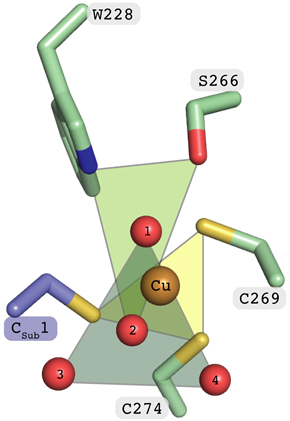Structural insights into molecular oxygen binding and activation by formylglycine generating enzyme
In biological systems copper plays essential role in redox catalysis. Protein-bound can cycle between the oxidative states I, II and possibly III and thereby facilitate binding and activation of substrates. [1, 2]
The formylglycine generating enzyme (FGE) is a novel copper dependent oxidase, which participates in the activation of sulfatases in bacteria and animals. FGE catalases an O2-dependent conversion of specific cysteine residue to formylglycine through the abstraction of the peptidyl-cysteine pro-(R)-β-hydrogen [3]. According to the recent structural investigations, FGE in the resting state has a single Cu(I), coordinated only with two cysteines in the linear geometry. The analogous sulfur rich coordination is common for copper trafficking proteins and transcription factors, but unprecedented among copper-dependent oxidases, which predominantly bind the metal in the histidine-rich tetrahedral or square planar coordination geometry. In contrast to the copper trafficking enzymes, FGE active site can bind and activate O2 to abstract H atom from C-H bond. [4-6]
In this presentation we will describe the crystal structure of FGE from T. curvata in the complex with Cu(I) and a substrate peptide. This high-resolution structure, together with NMR spectroscopy and kinetic data, revealed an acidic O2 binding pocket, closely located to the copper center. This FGE active site feature plays key role in O2 activation.

The schematic representation of Cu(I) coordination sphere in the crystal structure of tcFGE in the complex with substrate analog.
[1] E.I. Solomon, et al., Chem Rev, 2014, 114 (7), 3659-853.
[2] W. Keown, J.B. Gary, and T.D. Stack, J Biol Inorg Chem, 2017, 22 (2-3), 289-305.
[3] J. Fey, et al., J Biol Chem, 2001, 276 (50), 47021-8.
[4] A. Messerschmidt, in "Comprehensive Natural Products II: Chemistry and Biology", 2010, 8, 489-545.
[5] M. Meury, M. Knop, and F.P. Seebeck, Angew. Chem. Int. Ed. Engl, 2017, 56 (28), 8115-8119.
[6] M. J. Appel, et al., PNAS, 2019, 16 (12), 5370-5375.